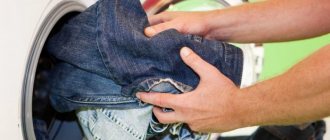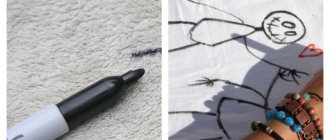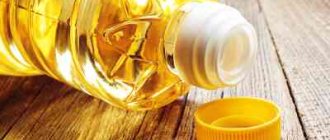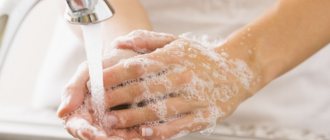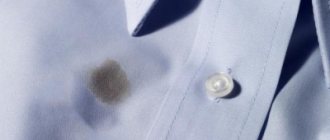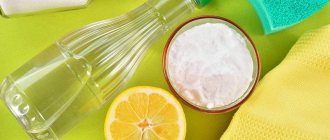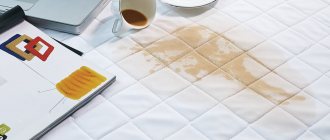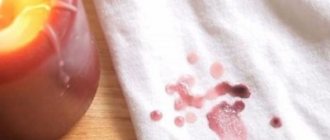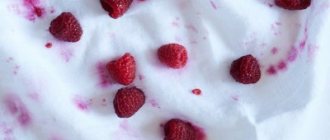How to properly wash sunflower oil from clothes at home. Mothers and grandmothers considered such spots practically invincible. Fortunately, over time, housewives learned to deal with them. Today there are many simple methods using available tools.
The difficulty in removing stains from vegetable oils is that they do not dissolve in water. Such contaminants can be effectively combated only at high temperatures or by pre-treatment with a substance that dissolves fat molecules. It is important to consider the type of fabric and the durability of the mark itself.
- How to remove traces of vegetable oil
- Proven means
- Subtleties when working with different materials
- Removing old stains
- Removing butter
- Expert advice
How to remove traces of vegetable oil
Vegetable oil stains, like any other stains, are easier to remove while they are fresh, so you need to act immediately. Timely measures taken are the key to success. What to do:
- Wetting its outer edges with cool water will help prevent contamination from spreading.
- The newly created stain should be blotted with a paper napkin without rubbing it. This will prevent oil from penetrating deep into the fibers of the fabric.
- The remaining mark must be treated with dishwashing detergent, applying it with patting movements, rubbing in, but not smearing. This should be done with your fingertips from the edges to the center.
Expert opinion
Irina. Housewife.
Ask a Question
Important! Timely measures will help remove the oil stain quickly, without damaging the fabric.
Sources and nature of pollution
The most common sources of oil marks on clothing are cooking, cosmetic, and industrial oils (grease).
They leave bright, blurry spots that do not have a clear outline, which over time become covered with a layer of dust, fade and become dull. Old stains become visible on the reverse side of the fabric.
Proven means
Salt
Kitchen salt has the ability to absorb liquid. Sprinkle it generously on the stain, and after 15-20 minutes shake it off and replace it with a new one. Then the item is washed in the usual way.
Important! This approach is suitable for any type of fabric, including delicate ones.
Dishwashing liquid
Dishwashing detergents, such as “Fairy”, “Gala Cold Power” and others with grease-dissolving components, successfully cope with any oil stains on all types of fabrics.
In their pure form, they are generously applied to the dirt and left for 30-60 minutes. After which the item must be washed in the usual way. This method is suitable for all types of fabrics and clothing, including carpets and upholstery.
Important! If there is a large area of dirt, the entire item must be soaked in a solution of dishwashing detergent and water.
Mustard powder
Dark things can be saved with mustard powder.
It is diluted until a homogeneous and thick mass is obtained. The composition is applied to the contaminated area for 40-60 minutes until completely dry. Then you need to shake it off and wash the product in the washing machine.
Important! This method is only suitable for dark things, since mustard tends to stain fabrics.
Soda
It is successfully used to clean grease and other contaminants from surfaces.
There are no contraindications to using soda for different types of fabrics. It should be sprinkled generously on the stain and left to act for 1-1.5 hours. Then you need to shake it off and evaluate the result. If necessary, repeat the procedure.
Gasoline and other solvents
A method known to everyone for many years and successfully used for removing oil stains is the use of purified gasoline.
The liquid is applied to the contaminated area with a cotton pad or sponge using blotting movements. After weathering and drying, the item should be washed as usual.
Stain remover
Preference should be given to special stain removers that are effective in combating greasy stains. They are used strictly according to the instructions.
Washing powder or soap
In most cases, neither soap nor laundry detergents can remove oil stains. Because they do not contain components that effectively dissolve fat molecules. They are used at the final stage, when the oil stain has already been removed.
Using starch
For delicate fabrics, use corn or potato starch.
You will need 2 more white napkins or kitchen towels and a hot iron heated to the temperature that is acceptable for this type of material. The product at the site of contamination must be moistened. The item is placed on the wrong side, previously sprinkled with starch. On the other hand, you need to do a similar action. Then the “structure” is ironed several times.
After this, you need to remove the napkins, shake off the starch and evaluate the result. Repeat if necessary. Wash the item as usual.
Plumbing cleaning products
Any kitchen surface cleaner will do.
It must be diluted with lukewarm water in equal proportions. Then the solution is applied to the stain and left for 20-30 minutes. After achieving the desired result, the item must be rinsed thoroughly.
Expert opinion
Irina. Housewife.
Ask a Question
Important! Use this method exclusively for resistant fabrics. It is contraindicated for delicate products. Before you start using the product, you need to test its effect on an inconspicuous area of the item.
Ammonia and turpentine
Turpentine and ammonia are combined in equal proportions, after which they must be diluted 1:1 with warm water. The mixture is applied to the oil trail with a sponge. Then, you need to wait about 20 minutes. Then the item should be washed.
Glycerol
It can be purchased at your nearest pharmacy.
A bottle of glycerin is immersed in warm (50-60 degrees) water for 20 minutes. Then the area of fabric stained with oil is soaked in the product and left to act for about an hour. After that, the area should be blotted with a napkin and the item should be washed.
Dentifrice
A practical housewife should always have it at hand.
Despite the fact that it has long been replaced by toothpaste, which is less abrasive, many household problems are solved with the help of tooth powder. It is diluted with warm water to a paste-like state and the solution is treated with a rubbing motion. After waiting 10-15 minutes, the paste should be washed off and the effect assessed. Repeat if necessary.
Important! This method will not damage delicate tissues.
Chalk
It has good absorbent properties.
Chalk effectively absorbs oil components. In addition, it is not capable of damaging delicate and delicate tissues. To remove a greasy stain with chalk, grind it to a powder and apply for 1.5-2 hours. As an alternative, it is permissible to use the method with an iron and napkins.
Important! You can replace chalk with Calcium gluconate tablets.
Shaving foam
It is successfully used for various types of fabrics as a vegetable oil stain remover.
It contains components that effectively dissolve fats. Expert opinion
Irina. Housewife.
Ask a Question
Important! Use foam. The gel has other components.
The bottle must be shaken before use and foam should be applied liberally to the stain and left for 20-30 minutes. Then blot with a clean and dry cloth, and then rinse with water. This procedure can be carried out several times without fear of damaging the product.
Important! This method is ideal for carpets and furniture upholstery.
White clay with vinegar
A mixture of vinegar and cosmetic white clay can successfully remove fresh and old greasy stains.
Clay can be purchased at cosmetics and household chemical stores. It is diluted with table vinegar to a thick paste. Then the mixture is applied to the contaminated area.
It should be left until completely dry. Residues should be shaken off or cleaned depending on the type of fabric.
Use of household chemicals
You can wash off vegetable oil with powder, soap, and even dishwashing detergent. The use of stain removers is also recommended.
Soap and washing powder
Using laundry soap or washing powder, you can wash away stains caused by spilled oil on the carpet. It is difficult to remove fat from dense and fleecy items because they are capable of absorbing a significant amount of liquid.
First, moisten the area around the stain with water to prevent it from spreading further. Now you need to carefully blot the center of the stain with a clean napkin until no greasy dirt remains on it, after which water is applied to the stain itself. To remove grease, soak a stiff clothes brush in warm water, rub a bar of soap with it, or lightly sprinkle the carpet with laundry detergent and vigorously rub the pile with a brush until a thick foam forms. Rinse off the detergent with water to ensure that the grease is gone.
In order not to spoil the floor covering, which is afraid of water getting in, place a layer of oilcloth under the carpet, and then a piece of clean cloth.
Dishwashing liquid
A very simple, effective and proven method. Take a suitable container and mix in it:
- 0.5 cups of warm water;
- 1 tbsp. l detergent;
- 1 tsp. l ammonia.
Mix well, soak a clean rag or cotton pad in the prepared solution and treat the area of the fabric from the wrong side. After this, cover the stain with paper and iron it with a warm iron.
Stain removers
In a situation where upholstered furniture or carpeting has been damaged by sunflower oil, it will not be possible to remove greasy stains using the traditional method. Specialized household chemicals that can remove stains without washing will help you cope with this task. Here are a few effective remedies:
- Chirton;
- Beckmann;
- Heitmann.
Subtleties when working with different materials
The cleaning method must be selected taking into account the type of product and material. Different substances behave differently on different types of tissue.
Jeans
Denim quickly absorbs vegetable oil. Contaminants instantly penetrate the fibers. Therefore, to remove oils from denim, soaking methods are suitable, the time of which should be increased. The advantage is that these products can be washed at high temperatures, which dissolve oils.
Raincoat
Jackets, bags and other items made from raincoat fabric are processed using any cold method. It is preferable to use dishwashing detergent. Initially, it is applied to the stain for a long-term effect of 1-2 hours. Then, the entire thing is soaked in it for 3-4 hours.
Knitwear
T-shirts most often suffer from vegetable oil getting on them.
Knitted items will not tolerate exposure to high temperatures and aggressive detergents. Preference should be given to gentle methods followed by soaking and washing. Do you wash by hand?
Oh yes! No
Carpets and upholstery
The difficulty in removing stains from these surfaces is that they cannot be washed or soaked. Therefore, it is preferable to use dry cleaning methods - soda, chalk, tooth powder or shaving foam (see above).
After the stain is removed, the remaining product is removed using a vacuum cleaner. The carpet or upholstery should then be cleaned completely with a damp brush and soap.
Expert opinion
Irina. Housewife.
Ask a Question
Important! It is easier to treat furniture upholstery or flooring if you have a steam cleaner. A washing vacuum cleaner also works great.
Trousers
An item of clothing on which traces of oils appear more often than on others and the reason for this is carelessness while eating. Problems with removal will not arise if fresh contamination is sprinkled with salt or soda, as in the above method.
Salt
Fighting animal stains
It can be butter or beef fat; no one is safe from the fact that herring oil will not get on your clothes while you are removing the bones. You can get rid of such stains, but the fight should begin immediately:
- Dish gel. It is slightly diluted with water, after which the solution is soaked into the stain.
- White spirit or acetone. You can use nail polish remover. Apply generously to the stain and leave for 20 minutes. Not suitable for synthetics!
- If butter gets on the upholstery of the sofa, you should cover it with a thick layer of baking soda, then wipe it with a rag soaked in stain remover.
Expert advice
To remove a greasy stain without damaging the product, you must adhere to the following recommendations:
- Any substance can only be used if it is safe for the fabric on which it will be used. Before proceeding to the treatment of the entire item, the product should be tested on an inconspicuous area of the product.
- There is no need to try to remove fat from the fabric by drying it, this will complicate the stain removal.
- The product must be processed by placing it on a washable surface, diaper or napkin. You should not do this on the sofa or carpet. There is a high probability that oil will stain the surface under the item.
- You should not increase the proportions of aggressive detergent components; it is better to repeat the procedure several times if necessary.
- Some items, such as suede and leather, are best taken to dry cleaning.
In fact, it is not difficult to wash sunflower or other vegetable oil from clothes. It will take a little time, effort and persistence.
First aid
To remove a vegetable oil stain that has just appeared on clothing, the first step is to apply a paper kitchen towel to the oil stains. This is necessary so that it has time to quickly absorb the bulk of the oily substances.
After this, you need to perform the following simple steps at home:
- fill a basin with warm water and immerse the soiled items in it for 20 minutes;
- after the specified time has passed, intensively rub the traces of sunflower oil with laundry soap;
- soak the clothes for another 10-12 hours;
- wash the item in the washing machine with added powder.
If you are unable to remove the sunflower oil stain from the fabric the first time, you will need to repeat the procedure.
Cleaning leather clothes
To remove oily stains from leather items that cannot be washed, use the following techniques.
- Wipe the stain with a cut onion.
- Treat the contaminated area with a cloth soaked in lemon juice.
- A paste of starch diluted in water is placed on the stain, and then wiped with gasoline using a cotton swab.
- Use soda diluted until completely dissolved in water 1:10. Soak cotton wool in the solution and treat the stain.
- Remove oil marks from leather items with alcohol or vodka.
- Wipes are suitable for cleaning TV and computer screens.
If necessary, use one of them.
Causes of grease stains
Unsightly oil stains appear on clothes for various reasons:
- due to carelessness at the table during a meal, a piece of fatty food or sauce containing oil ends up on clothes;
- during cooking, splashes of hot fat fall on the stove, dishes and cook’s clothes;
- oil stains appear on skirts and trousers if you accidentally sit on a chair stained with grease;
- No car repair is complete without oil stains.
Having discovered contamination, they try to eliminate it immediately using suitable household products.
